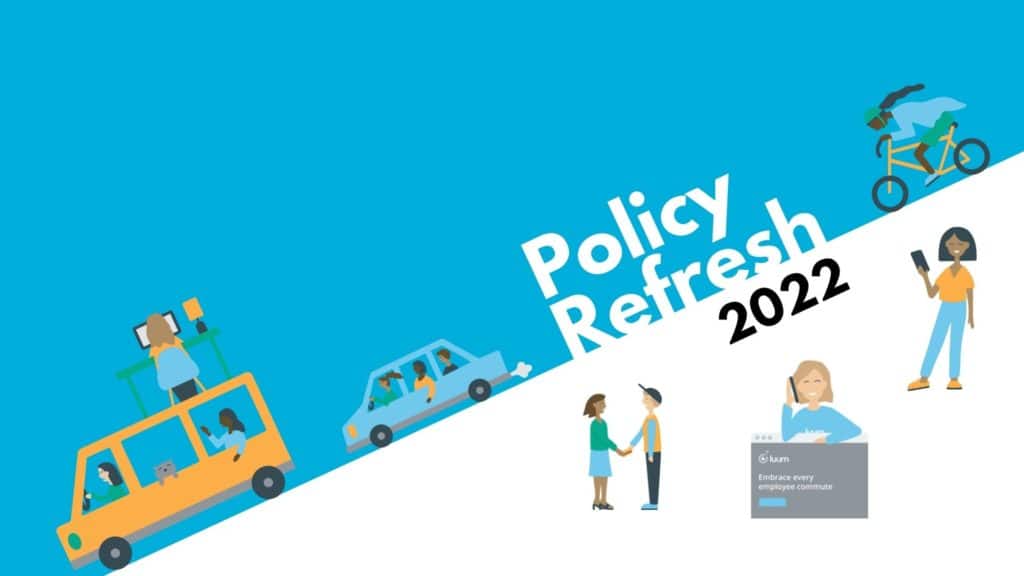Three Truths (and a fallacy) About Commuter Benefits
Understanding and improving the employee experience has been a key priority of Human Resource leaders since the inception of HR. Today, Senior Executives — from wide-ranging departments and roles — have made optimizing the employee experience, at all phases, a strategic business initiative.
One phase of particular concern for many large employers is the commute. We hear so much about customer experience (CX) and user experience (UX) but neither of those experiences really matter if you don’t have a plan to optimize the daily employee experience (EX), which starts invariably (and quite literally) with the commute.
Much has been made of the arduous commutes many employees face each and every day. Some of the hours-long commutes reported by people read like a dystopian novel: darkness, distance, and great suffering. The grind before and after the grind. Those unspeakable travails of daily travel.
Unfortunately, there is very little employers can do to change the infrastructure or subsequent time it takes to commute due to an infrastructure in disrepair. As an employer, you can’t control a lot of things related to the commute but can control the caliber of commuter benefits being offered at your organization.
Commuter benefits are tied to the commuter experience, which radically shapes the wider EX. Commute is the common experience that all employees share and while each commute is unique, your handling of each and every commute (via commuter benefits) plays an ever-increasing role in productivity, performance, and job satisfaction.
But what, exactly, can employers do to improve the employee commute experience? What are the considerations that go into managing commute? And how do we deliver commuter benefits that are actually valuable to employees? Let’s dig into these questions with a little something we’ll call Three Commuter Truths and A Fallacy…
Commuter Truth #1: Optionality, Say Hello to Flexibility
The question of should we offer commuter benefits is no longer an option for organizations that wish to remain relevant. Also gone are the days of the binary benefit: parking or transit. Giving your employees a choice between a parking pass or a transit pass is a great place to start but it fails to be inclusive of the full spectrum of commuters. In short, it lacks flexibility, which is exactly what the employee of today (and tomorrow) demands.

So, if binary isn’t the answer, what is? The key is to create a scenario where employees have a choice each morning––and any incentives/disincentives are designed to realize the precise commuter behaviors we’d like to encourage. We should allow employees to set aside pre-tax dollars for parking, transit, and rideshare services. Start subsidizing or reimbursing commutes via MaaS apps and offer amenities like bike cages, showers, and free tune-ups. Support flexible vanpooling and subsidize the cost for employees. Provide guaranteed ride home services with Lyft or Uber, so employees feel like they have the flexibility to leave their car at home in case of emergency. And finally, we should subsidize transit whenever possible so that fewer employees are choosing to drive-alone each day.
Commuter Truth #2: Pretax Commuter Benefits Are Vastly Underutilized…
To the detriment of both the employee and the employer. But since this is a post about employee experience let’s keep it EX focused! Two things to keep in mind here: a) your employees can save up to 40% on commuting costs (not to mention bring home over a thousand dollars more in annual pay) and b) only something like 13% of employers offer pre-tax commuter benefits, so pretax represents a very real opportunity to set yourself apart from the competition.
In today’s economy just giving your team the tools to self-enroll, make their own elections and have a simple, direct line of communication with your Commuter Benefits team makes all the difference in the world. In fact, we live in a world where this is happening in nearly every other facet of business, so why not the commute?!
Commuter Truth #3: Parking is the most important piece of the puzzle
Let’s face it, driving is how most Americans get from Point A to Point B—and that’s not changing anytime soon. But parking is not free. One new parking space can set an employer back tens of thousands of dollars in many Metro Areas, sometimes to the tune of an entire yearly salary! Then there’s the whole hunt is on aspect to parking that sees innumerable employees racing around, each day, looking for the right parking spot — stressing out and wasting time before they even enter the office. (Shameless plug: this is just one of the reasons why we built a robust Parking Reservations feature into the latest release of our app…more on this in an upcoming blog post.) And here’s the message that needs to be heard: It’s not about never driving – it’s about driving less.
And finally, the sunken cost fallacy is real, especially as it relates to employee parking. Your employees will park if they are paying monthly. Even if they want to engage in a healthier, alternative commute just a couple days per month. It’s a lose-lose that can be remedied by shifting to a more flexible commuter benefits model.
In order to provide greater flexibility in the commute, comprehensive pretax benefits (and subsidies), parking automation, and improve the overall employee commute experience it’s vital that you have the right technology to run these features, holistically.
It is technology that allows employers who administer commuter benefits to offer subsidies and/or incentives to employees who commute with third-party mobility providers like Lyft, Scoop, Strava, and Waze Carpool. These mode-specific incentives are automatically applied directly to their employees’ paychecks. The employer will also get the data about which employees are using ride-hail, biking or walking, and carpooling. For example, when an employee carpools using Scoop or Waze Carpool, the employer will know when an employee carpooled and with whom – allowing for richer data analysis, targeted communications, and directed incentives (like free or priority parking for carpools). Employees simply connect their apps and start carpooling. This provides flexibility, choice, and an enjoyable experience because employees can use the daily apps they already love for their (twice) daily commute.
Ready to make these truths a reality at your organization? Let’s talk!
More In the Luumlight
HR Dive: Enterprise employers navigate the hybrid commute
Our annual virtual conference, Luuminary22, was held on July 20th. We gathered a wonderful group of leaders to discuss the hottest topics of 2022: including…
Your hybrid workforce doesn’t need commuter benefits. They need mobility benefits.
Life is not the same as it once was. The workforce is continually changing, and so are employees’ needs, causing a rethink in the ways…
Return to Better: Commuter Benefit Policies For 2022 and Beyond
Daily flexibility and choice will keep your commuters safe, happy, and productive. Whether your workforce has been commuting throughout the pandemic or returning to office…



